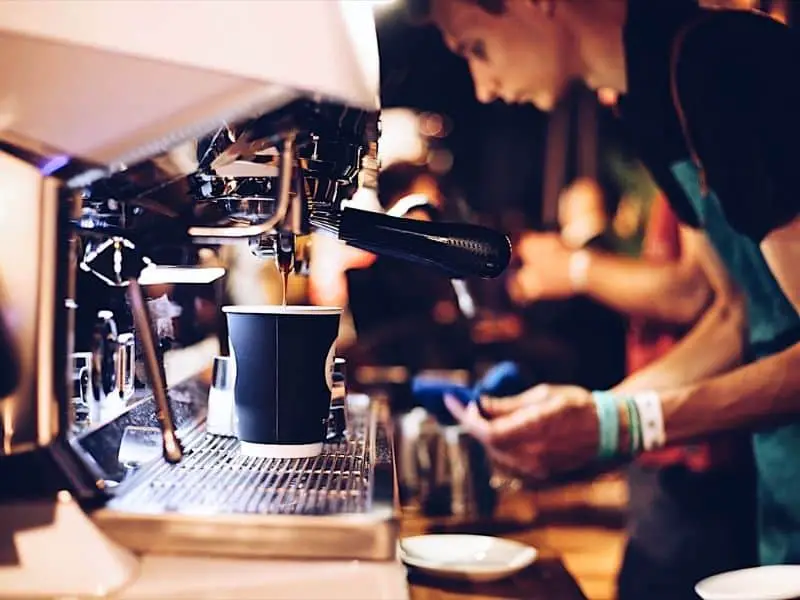Becoming a barista is a great way to get into the coffee industry. It can be a fun and rewarding job, but it does require some training and skill.
In this article, we’re going to look at what is a Barista, what do they do, and more.
Here is what you need to know about becoming a barista.
What is a barista?
A barista is a person who prepares coffee and other espresso-based drinks for customers in a café, restaurant, or coffee shop.
Barista is a fairly new job, even though it seems to have been around for ages.
Those of us who are, well let’s just say, of a certain age, will remember the coffee we used to drink in diners and restaurants was generally drip coffee, prepared and served by our waiter or waitress.
In fact, many breakfast and lunch places still serve coffee this way – the classic “truck stop” coffee.
Then came the espresso machine, and with it a new phenomenon, a destination where your favorite beverage was not just an adjunct to a meal, but the reason for the café’s existence – the coffee shop.
Suddenly a new skill was required – the ability to correctly make and serve a variety of espresso-based drinks – not just latte and cappuccino, but mocha, macchiato and cortado, and many others. Thus was born the Barista.

What does barista mean?
Since the espresso machine was invented in Italy, it naturally follows that most of the names and terms used around the operation of the machine are also Italian.
The word barista is an Italian word simply meaning “bartender”, although over time it has come to mean a skilled coffee shop assistant, knowledgeable in all the functions of the espresso machine, and able to create espresso-based beverages to the customers’ requirements.
A barista is expected to be also fully trained in the art of decorating the drinks with milk foam in stylish patterns, known as “latte art”, and to have an almost encyclopedic knowledge of the coffee bean to answer every customer question.
What does a barista do?
To start with, a barista “owns” the espresso machine – it is their workspace. At the start of each working shift, the barista checks the grind and the shot timing.
To get the best shot of espresso coffee, the way the beans are ground is important – too coarse and the coffee will be under-extracted, that is not enough of the coffee oils, acids and flavor will come through – and if too fine, the shot will be over-extracted, too strong and bitter.
The timing is also critical. The water should pour through the coffee grinds in around 25 seconds, and if too fast or too slow this is an indication that the grind is not correct.
Having set up the machine the barista checks that there are enough clean cups or mugs, or disposables, to serve the expected customers.
Sugar sachets, milk of various types (full cream, lite, non-dairy, etc) are available and at hand, and all is ready for the first customer.
When an order is taken, the barista either places the required amount of coffee grinds in the holder, called a portafilter, for a manual machine, or clicks the appropriate button on an automatic machine.
While the water is extracting the shot the barista steams the milk using the nozzle on the machine.
This is a separate skill, requiring concentration and understanding of the milk’s properties – how to create silky smooth milk with or without foam and how to heat it enough but not let it boil.
Milk steaming makes the high-pitched noise most associated with espresso machines, a feature of most coffee shops.
The barista then carefully pours the milk into the espresso shot to just about level with the top of the cup, forming a meniscus or slightly rounded top to the milk.
This is where the artistic skills come in when the barista makes patterns on the top of the drink using the remaining foamed milk in the jug.
At the end of a working shift, the barista will break down the machine and clean it, taking out various removable parts like the drip tray and portafilters and cleaning the “group heads,” which are the spouts that deliver the water to the portafilter.
Barista Competitions
Because it is a skill-based occupation, it is not surprising that there are regular barista competitions to test and hone their skills.
Usually, in such a competition a barista will be judged on three drinks; an espresso shot, a milk-based coffee, and a signature coffee – this being the barista’s own creation.
The judging also takes into account the barista’s coffee knowledge, not only of their job but also the whole process, from farm to table, how beans are grown and roasted, and the different varieties and blends.
Mostly these are local or national competitions, but there is also a World Barista Championship, held annually in a different country each year.
In 2021, it was held in Athens, Greece, and in 2022 it is scheduled to be held in Melbourne, Australia.
How to become a barista
In previous, less enlightened times, working in a café or restaurant was seen as a low-level, unskilled role, a blue-collar job. The skill level required for a barista has elevated this and has become a highly trained occupation.
One of the best ways to start on this road is to find work with one of the bigger chains, like Starbucks, Dunkin, Gloria Jeans, or even McCafe.
There the future barista will receive thorough training in all aspects of the job.
Starbucks in particular has a training course called “Coffee Masters”, which covers everything about coffee in-depth, including coffee tasting, identifying different bean types, and complete knowledge of the subject.
This program can take more than a year, and graduates of the Coffee Masters program can be identified by the black apron they wear, rather than the standard green Starbucks apron.
Final thoughts on becoming a barista
Becoming a barista is a great way to get into the coffee industry.
This job offers you hands-on experience with operating espresso machines and interacting with customers in a fast-paced environment. It can also be done part-time or full-time while going to school at the same time.
The only downside maybe that it usually only pays slightly above minimum wage so if you want more money, this might not be for you.
But if interaction with people and learning about making coffee are your goals then being a barista could work out great.
FAQs
What is a male barista called?
The word barista is used in English for both male and female staff, and the same in Italian.
In English usage the plural is simply “baristas”, although in Italian the plurals change with gender – the plural for males is “baristi”, and for females is “bariste”.
Is a barista only for coffee?
While a barista may have other duties, like taking orders, helping to clear tables, etc, this title is used only for the role of a person who operates the espresso machine.
How much does a barista make?
In most countries, a barista is paid a little above the minimum wage in recognition of their training.
The average in the US is around $12.50 an hour, similar to most Western, English-speaking countries, like Australia and the UK.
In developing nations, it is a lot lower. For example, a skilled barista in Vietnam would expect to earn around $300 a month.
How much does a Starbucks barista make?
A Starbucks barista typically earns more than other baristas.
However, there is a lot of variation depending on the region and the individual’s experience and skills.
In the United States, they make on average $13 per hour, £9 per hour in the United Kingdom, and A$21 in Australia.
